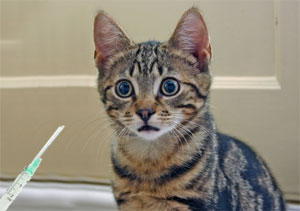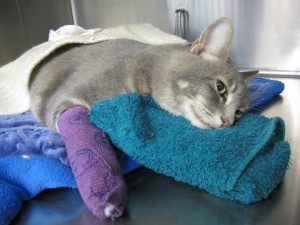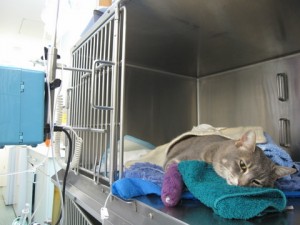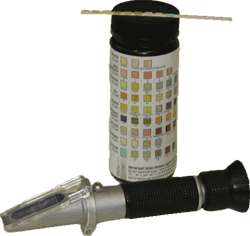Indoor cats straining to urinate and not producing much but bloody urine have bladder problems. Some exhibit their frustration and pain all over the house.
The urinary passage of male or desexed male cats can block up with crystals and mucous. If your cat is tense and restless then he may have a blockage and you must contact a vet immediately before the bladder bursts.
Stress causes bladder inflammation or cystitis in some cats.
Kidney or bladder infections and bladder stones cause similar signs.
When you come to the vet surgery we examine your cat for urinary blockage and shock. Then we analyse your cat’s urine for infection, crystals and mucous plugs. We might order an X ray or ultrasound to rule out bladder stones.
If we find no sign of blockage, infection or stones then we conclude that your cat has Feline Lower Urinary Tract Disease (FLUTD) or Interstitial Cystitis (FIC).
Contributing causes:
No single cause of FIC has been identified. However, several factors have been shown to increase the risk of FIC. These include:
Stress
- Indoor confinement
- Dry food
- Obesity
- Low water consumption
- Sedentary lifestyle
- Frequent meals
How can you prevent further episodes of FIC?
- Introduce a predominantly wet food diet such as food in sachets or cans, or raw meat. If your cat prefers dry food you may have to introduce the new foods gradually. Add a little of the wet food to the biscuits and gradually increase the amount of wet food. Alternatively sprinkle the biscuits with water and increase the amount of water added over a few weeks until the biscuits are soft and wet.
- Increase your cat’s water intake. You might try adding more water to the food or offering water flavoured with chicken stock. Some cats like running water. Pet fountains are available in many pet stores. Cats often like drinking water from the shower recess or basin. Provide water in a variety of bowls in different shapes, sizes and textures to identify your cat’s preference. If rain water or filtered water is available your cat may prefer it to tap water.
- Encourage frequent urination. Provide at least one litter tray per cat plus one more filled with the preferred litter and in private locations.
- Reduce stress in your cat’s life. Some cats are very sensitive to their environment and may respond to any changes by becoming nervous or fearful and developing problems such as cystitis. A comfortable quiet hideout for resting, such as a cupboard, quiet bed or sofa, or on top of the refrigerator, is essential for all felines. Some nervous individuals may require a refuge in a quiet, sheltered part of the house away from other pets and people, and furnished with the necessities of life.
- Minimise interaction with other cats for fearful individuals. Check out the Indoor Cat website for signals that your cat is on edge. You may have to provide a feeding point, litter tray and hideout for each cat to minimise th
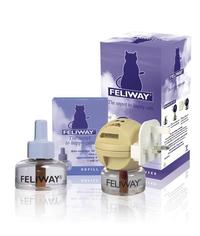 e tension.
e tension. - A Feliway diffuser may help to reduce stress in many situations.
- Enrich your cat’s environment. When we confine our cats indoors they become dependent on us not only for their physical needs and environment but for their emotional and intellectual needs as well. Cat scratching posts, toys that mimic prey, tunnels, outside runs and a variety of high spots and hideouts will keep your cat happy and stimulated. Your company is important. Even an old cat will appreciate a game with a ribbon on a stick or a glittery ball. Make your cat work for food by hiding it in various locations around the house or in food puzzles such as plastic containers with holes cut in the sides. The Indoor Pet website has lots of suggestions.

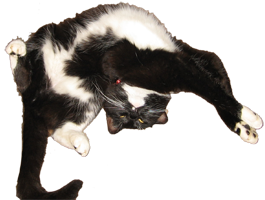

 Protect family and pets with a solar powered snake repeller. Makers of the Sentinel snake repeller claim that it repels all snake species and is safe to use around children and animals.
Protect family and pets with a solar powered snake repeller. Makers of the Sentinel snake repeller claim that it repels all snake species and is safe to use around children and animals.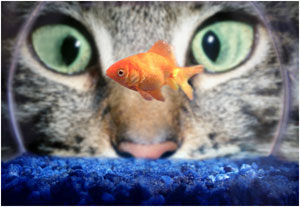 Frequently asked questions about cat registration.
Frequently asked questions about cat registration.